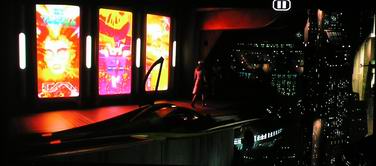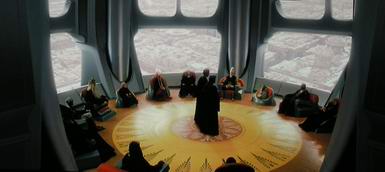"AI" Artificial Intelligence
The term AI is getting very popular with home theater projectors. In using the term AI, or artificial intelligence, manufacturers are not describing the ultimate in AI, a computer that theoretically demonstrates real intelligence (learn more? search for Turing Engines in your favorite resource). In the world of projectors it normally means
using software to analyze the image frame by frame and adjusting the image to yield the best results. And the primary direction companies use AI for is to produce "blacker blacks" Two popular adjustments used are:
1. Dynamic Iris. Some projectors have an iris behind the lens, which can open or close to let out more or less light. If an image has no really bright areas, by closing the iris part way down, everything gets darker, so areas that should be black, now get closer to that ideal. At the same time an area that should be 40% white would also dim, but the projector would adjust the brightness of that area to maintain the correct brightness. (If the iris blocked 50% of the light, the projector's AI would adjust that part of the image to 80% so, that after the drop of 50% it is still the correct 40% brightness desired.
2. Variable lamp. Very similar, but instead of an Iris opening and closing, the lamp actually brightens or dims, frame by frame. With the same general result.
The Optoma uses AI in conjunction with variable lamp brightness. (That's why, if you have AI turned on, you cannot change the HD72 lamp's brightness setting.)
The drawback to most AI, is that to darken the blacks, you can only accomplish this with frames that don't have any really bright areas. If you have an area of the scene that is supposed to be full white (or a fully bright color - red, etc.), then if you dim the lamp, or close down the iris, you cannot get the full brightness of that white or color. Effectively the AI is disabled.
Quicktip: This has posed a serious problem for me recently in my photo shoots. Since I switched to Oppo DVD players in both my theater and testing room, when I pause an image to photograph it, a small pause indicator, appears toward the top right of the frame. (You can see that in some of the photos, but it's cropped out of others). Unfortunately, the pause indicator is full on white. On darker scenes, I can actually see the image on the screen change on the HD72 when I hit pause, as the AI can no longer dim the lamp for fear of not having the pause indicator be bright enough. I am going to check with Oppo, to see if this can be disabled.
As a result, what I see watching the DVD's (or HDTV) with AI on, and what is on the screen for me to capture when I hit pause are definitely different, with the actual being better than the captured image. My commentary as to how I find shadow detail, etc., is based on what I see while watching, not the captured photos, which at best approximate what is on the screen - remember, as mentioned before the camera also has limited dynamic range.
was even softer than the Panasonic on DVD when I reviewed it. That leaves (of the most popular models), the Sanyo Z4. I don't have one of those here at the moment, but the Z4 was definitely sharper than the Panny 900u (check out that comparison review), and I would venture to guess that the Sanyo Z4 is a touch sharper than the HD72, at least on DVD.
I recently completed the review of the Sony HS51A, which is a step up in price, and I would say that, the Optoma HD72, like the Sony HS51A, is very sharp.
My own BenQ PE8720 is a real step up in sharpness from both, but all's fair, it sells for about 3 times the price and has a lens that is probably over twice the size found on any of these other projectors. (Other projectors with sharpness rivaling my BenQ tend to be in the $10,000 and up price range.)
Bottom line: The HD72 produces, an excellent image in terms of sharpness, for its price.
Quicktip: Remember, DVD's are lower resolution than the projectors anyway, so you'll get a big boost in viewing sharpness, soon, as Blu-Ray DVD, and/or HD-DVD come to market, with higher resolution, true Hi Def movies. Of course, you'll have to go out and buy your favorite DVD's all over again. I should note, that for most of my testing I have my Oppo DVD upscale to 720p, but, ultimately, the source material on today's DVDs is still 480i.




